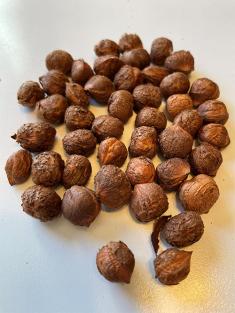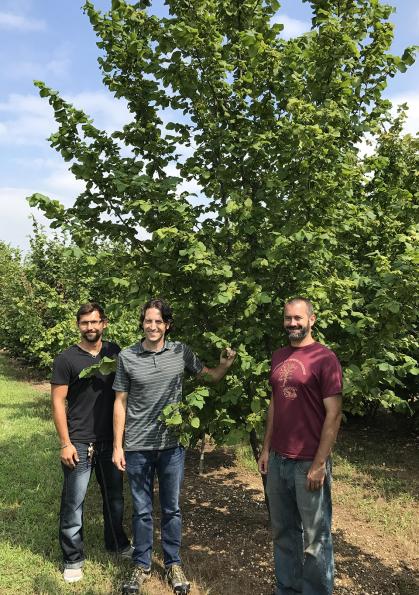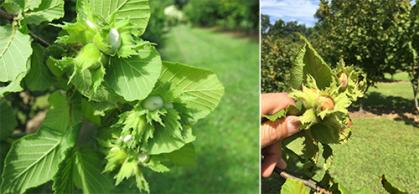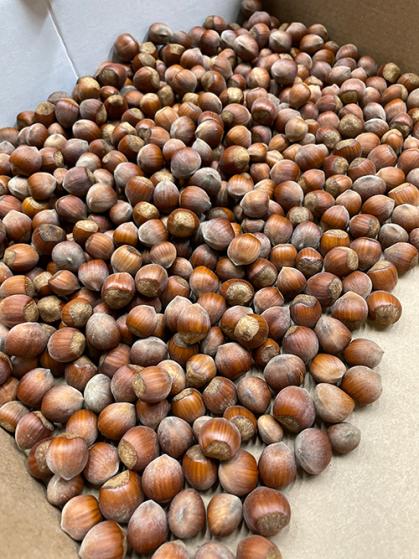- Agricultural Products
- Hazelnuts
-
The Beast
Hazelnuts: The Beast
Overview

Variety: The Beast
Principal Investigator(s): Thomas Molnar, Shawn Mehlenbacher
Strengths & Qualities
- High yielding "hybrid" hazelnut tree with small nuts and adequate blanching after roasting, making it suitable for a variety of confectionary and baked good applications as well as for direct eating once roasted
- Kernels do have a high level of fiber compared to the other cultivars, but this is removed during roasting
- Vigorous, upright tree with a moderately spreading growth habit
- Trees at 15 years can reach over 20 feet tall
- Carries an EFB resistance gene from C. americana 'Rush' that has been shown to provide excellent protection from the causal fungus (it is susceptible to bud mite in Oregon, but this has not been observed in New Jersey)
- 'OSU 541.147' The Beast nuts have an attractive, chestnut brown shell and a majority (>85%) drop free from the husk and fall cleanly to the ground at maturity
- Nuts typically fall in the 2nd half of September
- 'OSU 541.147' The Beast is suggested for use primarily as a pollinizer in New Jersey, but growers may find that its consistent high yields of nuts outweigh its small kernel size
- Tests have shown it can be grown in USDA Zone 5 making it a possible production cultivar in colder regions
- Regarding pollination, it has S-alleles 8 and 23 with S8 expressed in the pollen, and blooms in the early to mid-season in New Jersey
- More cold hardy than most pure European hazelnuts, which expands the regions in which it can be grown
- Pollen shed occurs a few days later than 'Raritan', 'Monmouth', 'Hunterdon', 'Somerset', with its female flowers emerging a few weeks later than 'Monmouth', 'Hunterdon', and 'Somerset', and along with 'Raritan' depending on the season
For Growers
- We are recommending that it be grown primarily as a pollinizer in the Mid-Atlantic region since it produces abundant, cold hardy catkins with compatible S alleles. However, it should be noted that some growers are not concerned with the smaller nut size and have decided to plant it as a production cultivar due to its regular high yields, particularly in colder areas that may not support our other production cultivars.
History
'OSU 541.147' The Beast hybrid hazelnut has a history of development spanning over 30 years that includes a connection to hybrid hazelnut breeding that began in the early 1900s. It is considered a "joint" release by the Hybrid Hazelnut Consortium, which is comprised of Rutgers University, Oregon State University, the University of Nebraska-Lincoln, and the Arbor Day Foundation. The cultivar was originally selected in Oregon from a cross made in 1990 by Shawn Mehlenbacher and Dave Smith between the F1 Corylus americana x C. avellana hybrid NY 616 and the Oregon State University C. avellana breeding selection OSU 226.118.
'OSU 541.147' The Beast was first propagated in 1997 and entered a replicated trial at Oregon State University for evaluation. While the selection was later shown to not meet commercial quality standards expected for the Oregon industry, its superior level of disease resistance, good kernel traits, and high yields (for a "hybrid" hazelnut) suggested its value for testing in eastern locations. Trees were first sent to Rutgers in 2002 and established in field trials at both the Rutgers Cream Ridge Specialty Crop Research and Extension Center (Cream Ridge, NJ) and Hort Farm 3 (East Brunswick, NJ) to evaluate response to EFB as well as adaptation to New Jersey's climate. The trees were grown at Rutgers for the next ten years, where they were found to be productive, free of cold damage, and completely resistant to EFB while thriving under low maintenance conditions. Trees of 'OSU 541.147' were also challenged with the EFB pathogen collected from around the eastern U.S. in controlled greenhouse inoculations, and again all trees remained free of disease!
Additional research at Oregon State University during this time showed that C. americana 'Rush' transmits a single R-gene in a predictable manner to its offspring, and this R-gene is found in a different genomic region than the 'Gasaway' R-gene–the one that protects current cultivars grown in Oregon. Thus, 'OSU 541.147' The Beast is protected by a resistance source that differs from that currently used by cultivars in Oregon, such as 'Jefferson', 'Yamhill', and 'Dorris'. It also differs from the resistance sources present in the Rutgers' cultivars 'Raritan', 'Monmouth', 'Hunterdon', and 'Somerset'. Further, the 'Rush' resistance source, as demonstrated by NY 616 and the other related NY selections (NY 398, NY 110, etc…), has been shown to hold up to EFB in the eastern U.S. and Ontario, Canada, since the 1940s, which supports its durability. Thus, adding 'OSU 541.147' The Beast to eastern orchards will diversify sources of resistance, which we expect will help growers manage EFB in the long term.
The Name
In 2016, Shawn Mehlenbacher and Tom Molnar were visiting Rutgers to tour the hazelnut plots. While heading to one of the original fields at the Rutgers Cream Ridge farm, planted about fifteen years earlier, Tom excitedly said to Shawn, "You have to see the 541.147 tree in the 2002 trial! You can spot all the individual trees from a distance. It is a BEAST!"
Tom brought Shawn to the plot, which is on a slight hill and lets you observe the entire field at a distance. It contained thousands of trees, but most had succumbed to EFB over the years. And on that part of the farm the soil is also quite poor, so even those trees that didn't die from EFB were struggling due to drainage issues and shallow soil conditions. But not '541.147'! It was included as a control tree distributed in each row and its positions across the field were easily identifiable from the top of the trial. It was thriving across the plot and had grown significantly taller and wider than virtually all the other trees, and had good crops of nuts to boot. It was a clear winner!
Shawn laughed and agreed, "'541.147' really is a Beast!". Tom and Shawn shared this story about how well the '541.147' tree was doing at Rutgers with other Hazelnut Consortium members at the University of Nebraska and the Arbor Day Foundation. Shawn teased that Tom jokingly called it "a Beast" and agreed it really looked great under those challenging conditions. From this point, we surmise that is simply became easier for our colleagues to remember the phrase "that beast tree" or "the beast" than the identification number 'OSU 541.147'. So, over the next few years as we continued to evaluate the plant for its potential, this nickname took hold internally, although with no intentions to make it official.
However, the situation changed when, at a nut growers meeting in 2019, the tree was referred to by some of our other hazelnut growing colleagues (not part of the Consortium!) as "The Beast" tree, and they were eagerly asking when it would become available. Somehow by that point, the nickname had been leaked, and people in the hazelnut community were buzzing about "The Beast" and its potential. We realized that the tree does grow like a beast (it is very vigorous and robust) and people are starting to know it by that name so we might as well go with it. Upon its release, we officially gave it the name "The Beast", and that's how history is made…
Intellectual Property
- US Plant Patent No. PP33,561 issued on October 19, 2021
- Corylus Plant Named 'The Beast'
Photos



Contact Us
Contact: Christine Chow
